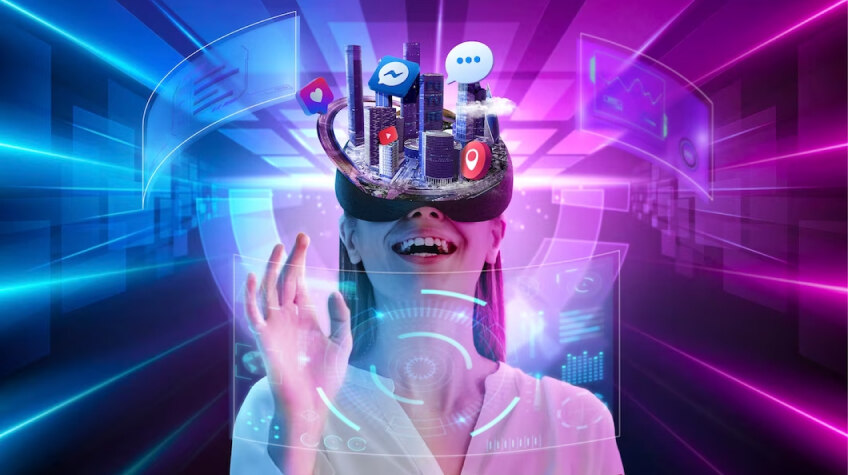
In today’s rapidly evolving technological landscape, Virtual Reality (VR) has emerged as a groundbreaking tool with transformative potential across industries. From immersive gaming experiences to advanced simulations in healthcare and education, VR offers limitless possibilities.
However, the successful development of VR applications requires the expertise of planning and execution-led experts or full-stack app-developing companies. You need to hire full-stack software developers who have experience in developing VR-integrated apps. The experienced developers not all help you develop VR-integrated apps but also provide expertise to make your app stand out from the competition.
In this article, we offer comprehensive strategies for effectively navigating the intricacies of VR development, all while harnessing the prowess of full-stack software developers. From the initial concept to the final deployment, this guide will provide a roadmap for ensuring your VR project’s success.
What are the Strategies for Successful Planning and Implementation of Virtual Reality Development?
According to Statista, the anticipated expansion of the global VR market is set to see it grow from under 12 billion U.S. dollars in 2022 to surpass 22 billion U.S. dollars by the year 2025. Hence, with the surging global market in up upcoming years, to make your virtual app stand out from the competition you need the right strategy to develop high-performing and futuristic VR software for your users.
Hence, here are the strategies that you should follow to make your VR software look and perform at its best:
I. Defining Your Vision
Before embarking on a VR development journey, it’s crucial to establish a clear and inspiring vision. Consider the following steps:
Brainstorming and Ideation
Gather a diverse team of creatives, developers, and industry experts to brainstorm ideas and identify the core purpose of your VR project. Engage in lively discussions to spark innovative concepts.
Market Analysis
Dive into the VR landscape, analyzing trends, consumer behaviors, and emerging technologies. Identify gaps and opportunities that align with your project’s goals, ensuring a competitive edge.
Defining Objectives
Set specific, measurable, achievable, relevant, and time-bound (SMART) objectives for your VR application. Determine whether you aim to entertain, educate, or transform experiences.
II. Planning and Resources Allocation
A well-structured plan is the cornerstone of efficient development. Use these strategies to create a blueprint for success:
Project Roadmap
Develop a detailed roadmap that outlines each development phase, from conceptualization to final launch. Break down milestones and allocate realistic timelines to ensure a smooth progression.
Resource Allocation
Assign roles and responsibilities based on team members’ strengths. Collaboratively determine the skill sets needed, ensuring a harmonious blend of creativity and technical expertise.
Budgeting
Estimate costs meticulously, encompassing hardware, software, personnel, marketing, and contingencies. Allocate resources wisely to prevent bottlenecks. Moreover, if you want to develop software under your budget and prevent bottlenecks you can check the blog on tips to cut the cost of software development. The blog will help you with impressive tips that will help you reduce your web app development cost and complete your app development under budget.
III. Design and Development

The design and development phase is where your VR project transforms from concept to reality. Employ the following strategies to cultivate innovation and precision:
Storyboarding
Craft a visually captivating storyboard that paints the user’s journey. Map out interactions, environments, and potential scenarios, providing a blueprint for the development team.
Prototyping
Develop a basic interactive prototype that showcases core functionalities. This prototype serves as a tangible foundation for user testing and early-stage feedback.
Iterative Development
Embrace an iterative approach, weaving user feedback and evolving requirements into the development process. Regularly refine and enhance the VR experience based on insights gained.
IV. Technical Aspects and Execution
The technical foundation of your VR project is paramount. Navigate this stage effectively with these strategies:
Platform Selection
Scrutinize available VR platforms (such as Oculus, HTC Vive, or emerging alternatives) based on your target audience, project complexity, and budget constraints.
Optimization
Pay meticulous attention to optimizing graphics, interactions, and overall performance. Strive for a seamless experience that immerses users without technical hitches.
User Interface (UI) and User Experience (UX)
Collaborate with UX designers to craft an intuitive and engaging UI that complements the immersive VR environment. Prioritize user comfort and seamless navigation.
V. Testing and Quality Assurance
A robust testing phase guarantees a polished and user-friendly VR application. Implement these strategies for a flawless end product:
Functional Testing
Conduct rigorous functional tests, covering all possible user interactions and scenarios. Address bugs, glitches, and inconsistencies promptly to ensure a seamless experience.
Usability Testing
Enlist a diverse group of users to participate in usability tests. Gather insights into user behavior, preferences, and pain points, refining the application accordingly.
Bug Tracking
Implement a comprehensive bug-tracking system that logs, prioritizes, and resolves issues systematically. Maintain open communication between development and testing teams.
VI. Deployment and Launch
A successful launch requires careful orchestration. Elevate your launch strategy with these proven tactics:
Marketing Strategy
Develop a multifaceted marketing plan that generates anticipation and builds awareness prior to launch. Utilize social media, influencers, teasers, and interactive content to engage potential users.
Distribution Channels
Strategically choose distribution channels based on your target audience. Evaluate platforms like Steam, Oculus Store, or independent websites, aligning with your project’s visibility goals.
Launch Plan
Coordinate a meticulously planned launch that accounts for technical support, user inquiries, and feedback collection. Ensure users feel supported and valued from day one.
VII. Post-Launch Support and Updates
Sustaining success hinges on continuous post-launch support and innovation. Foster long-term engagement using these strategies:
Customer Support
Offer responsive and empathetic customer support channels, promptly addressing user inquiries and concerns. Build trust and loyalty by valuing user feedback.
Gathering Feedback
Encourage users to provide feedback, suggestions, and insights. Use this information to make informed decisions about updates, improvements, and future directions.
Regular Updates
Establish a schedule for regular updates that introduce new features, content, and enhancements. Keep the VR experience fresh and exciting, enticing users to remain engaged.
Conclusion
The exciting process of developing virtual reality requires careful preparation, creativity, and commitment. You’ll be able to handle the challenges of VR creation while simultaneously producing an engaging user experience by following these all-inclusive tactics. Accept the potential of virtual reality as a tool for transformation and creativity, and set off on a trip that promises creativity, interaction, and an endless array of possibilities in the VR world that is constantly changing.






